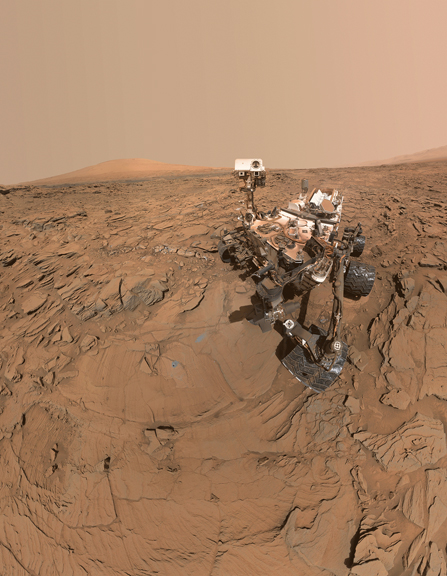
Curiosity Self-Portrait at ‘Okoruso’ Drill Hole, Mars.
By Charly SHELTON
In 2012, a visitor from Earth touched down on Mars. Landing in Gale Crater with a two-year mission to examine the geology of three-mile-high Mount Sharp located within the crater, the Curiosity rover has been driving up the side of the mountain since that time and is about to make a foray out to a new area and reach new heights.
“NASA chose to send Curiosity to Gale Crater because of Mount Sharp. Each layer of the mountain formed after the one below it and recorded a different snapshot in the history of Mars. We are literally driving through the history of Mars and every new region has a story to unfold,” said Ashwin Vasavada, Curiosity project scientist at the Jet Propulsion Laboratory. “The story of Glen Torridon is going to be a good one, I think.”
Glen Torridon is the rover’s next location as it moves up the mountain, nearly 1,000 feet off the crater floor. The new area is named for Torridon, a village in the Northwest Highlands of Scotland situated on the Torridonian Supergroup, a geological formation with rocks that have some of the oldest evidence of life in the United Kingdom. This is fitting as Glen Torridon on Mars was chosen by the orbiter when it detected clay minerals, a sure sign that water was once there, and hopefully with water comes readings of life-forming conditions once being present.
“Curiosity was sent to Mars to figure out if the ancient environment was capable of supporting life, whether or not life ever actually existed,” Vasavada said. “We look for signs of water, carbon-based molecules that could serve as the building blocks of life, and sources of energy or nutrients. Our best information comes from drilling into rocks that are about three billion years old and analyzing the drilled powder with two onboard laboratories. One laboratory can detect minerals that tell us whether water was present, and whether that water was not too salty, acidic or hot for life. The other laboratory can find carbon-based molecules and tell how complex those molecules might have been.”
Curiosity is now more than six years into its two-year mission parameter and about half of its plutonium fuel source is depleted. But NASA will keep the mission going as long as it can, as long as the science is still being sent home, Vasavada said. After more than three times its life expectancy, though, parts are starting to wear down. The computer had to be replaced with the onboard backup, sent along for just such an occasion, and the motor for the drill is giving the scientists problems, beyond drilling into especially hard rocks as well.
“Curiosity has overcome a lot in the past year, both re-inventing the way we drill to getting around a broken motor and recovering from a problem with our computer memory,” Vasavada said. “This makes getting back to scientific discovery all the more sweet for our scientists and engineers.”
The Curiosity mission can be followed on the Mars Blog Mission Updates at Mars.NASA.gov/MSL.
